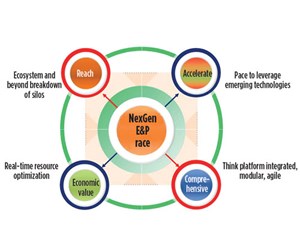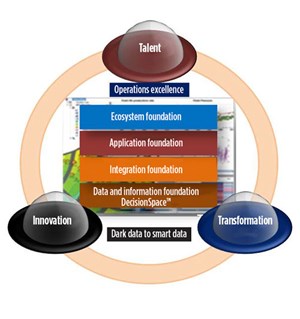Digital transformation essential for E&P industry to thrive in new economy
The upstream industry has implemented several types of digital oil fields and smart field technologies. However, this should not to be confused with digital transformation. The concept of the digital oil field is defined by Andre (2016) as “having the tools and technology to maximize the profitability of the field, and make it as secure and environmentally responsible as possible in a mostly automated way. And to achieve that, it is necessary to bring the data of many disparate systems (reservoir, production, network, supply-chain, models/simulation, maintenance and operations) to process/analyze data and find the ideal balance for one’s operation and field.”
Digital oil fields leverage the two well-known concepts: digitization and digitalization. In brief, digitization is defined as the representation of an object, image, sound, document or signal (usually analog) by generating a series of numbers that describe a discrete set of its points or samples. Strictly speaking, digitizing simply means the conversion of analog source material into a numerical format. Digitization of processes and information flows allows efficient collection of data from the field. For example, supervisory control and data acquisition (SCADA) and distributed control systems (DCS) in the upstream industry. However, this, in itself, is not sufficient to transform an industry or an organization.
The next phase of digital transformation is digitalization, defined by Gartner as “the use of digital technologies to change a business model and provide new revenue and value-producing opportunities; it is the process of moving to a digital business.” Digitization helps increase the efficiency of processes. Digitalization makes use of emerging technologies to engage with stakeholders to address specific challenges and needs in a cost-effective and efficient manner.
Digital oilfield programs have been managed as an infrastructure project, hence they are limited in creating significant value for the company and industry. In operations, digital oil fields of the future have been cautiously adopted and implemented, but never fully exploited by the industry. In contrast, the adoption of high-performance computing for seismic studies was a major shift during the last decade. However, the use of grid computing and cloud technology is still at infancy.
DIGITAL EVOLUTION/REVOLUTION
Digital transformation for the upstream oil and gas industry is poised to revolutionize the next generation of E&P technologies. It will permeate and profoundly influence our industry in several different ways as outlined below, Fig. 1.
Encroachment on historical boundaries. The reach extends beyond the silos and the traditional boundaries of an enterprise/unit. The scope should go to the outer boundaries of the ecosystem. This requires the development of new approaches to increase interactivity in the upstream environment, to address a variety of challenges for the overall benefit of the industry.
Reduce project timeframe. We must accelerate the pace of development and deployment to generate value from our digital assets. However, this requires several tasks to be completed at speeds that challenge the status quo. The emerging technologies enable us to define new and innovative solutions, and put them in practice to improve products and services across the oilwell lifecycle. In fact, the adoption of accelerated pace should become a systematic phenomenon for the upstream industry, in general.
Integrated/interactive platform solutions. The comprehensive nature of the digital transformation will enable us to rely more on integrated, agile and modular platforms to create value from the vast amount of data available in the E&P industry. An example is Landmark’s DecisionSpace platform that enables large-scale collaboration on large quantities (terabytes) of legacy data and real-time information in upstream operations. The deployment of this platform in the cloud can increase collaboration globally, within the bounds of the governance framework required by regulatory authorities.
However, the current state of data quality in the upstream remains a costly and open challenge; but with platform solutions, a comprehensive, cost-effective quality assurance system can be deployed readily.
Economic value. The digital transformation will open new sources of value creation for the upstream industry. For example, the real-time optimization of productivity or value loss due to NPT and due to many root causes, could be mitigated by real-time insight generation and recommendations generated from the digital assets and big data analytics. As it stands today, there is significant value creation possible from developing and deploying insights for equipment failure, based on digital assets.
MISSION STATEMENT
Based on these concepts, I envision the upcoming digital transformation to cause a profound change in the E&P industry, enabled by digitization and digitalization intertwined with emerging technologies and big data analytics. Collectivity, this will impact workflows and processes across the oilwell lifecycle, as well as identifying new and innovative ways of coordinating the next generation workforce, governance and business models to promote continuous growth and value creation, Fig. 2. To fully exploit this opportunity, excellence is required in the following areas.
Data and information management excellence means that upstream companies adopt emerging technologies like social, mobile, cloud apps and software-defined solutions to enable business growth at an accelerated pace. This is important for performing real-time resource optimization, increase the growth of SMART data (formatted at the collection point for multiple applications) instead of DARK data (collected and stored for a single-use purpose) that the industry has amassed for years. It also allows access to data within the proper governance and security framework.
It addresses the comprehensive need for digital transformation. This excellence will come from adopting a platform strategy that is based on the foundation of integration, agility and modularity.
Operations excellence, rather than operational competence, is required to create value. The upstream industry is well-versed in operational excellence, which implies running business processes to deliver outstanding performance. The key objective of the operational excellence is to realize efficient and effective business processes, against the established benchmarks that are continuously analyzed and adopted. However, to transform our industry, we must adopt an operations excellence mentality, by leveraging emerging technologies with data-driven innovation throughout every aspect of upstream workflows in a holistic manner. The critical success factor for operations excellence is the breakdown of silos in enterprises, and the industry in general. Excellence in data and information management is a key enabler of operations excellence for the upstream industry.
Innovation excellence generated from data-driven processes is required to identify, assess, realize and deploy new products, solutions and services at an accelerated pace, to maximize their value generation. To gain excellence in innovation, the industry must adopt a continuous transformational concept of ideas-to-products, -services, and -solutions. This also requires a greater degree of interaction across an enterprise and requires a new strategy. Processing of Big Data plays a critical role in driving innovation and augments the industry’s rich source of first-principle based solutions.
Transformation excellenceis defined as the profound change in the way an upstream organization conducts business across the oilwell lifecycle, and results in fundamental changes in tasks and activities. It is the holistic management approach that leverages innovation excellence of the organization to positively impact the industry. It focuses relentlessly on the cost of supply.
Talent excellence requires that we break down silos within an organization to promote open sharing of knowledge to drive emerging technologies. The industry will need to hire differentiated knowledge workers, such as data scientists, to adopt and leverage the vast amount of data/information.
UNPRECEDENTED OPPORTUNITY
In other industries, IT has launched a system called “voice of the customer” to capture a client’s expectations, preferences and aversions.
In the similar fashion, Landmark has launched “voice of the oilfield,” which is designed to play a critical role in the digital transformation of the upstream industry. The system is based on the Internet of Things, Big Data analytics and other comprehensive approaches to innovation. As the negative impact of the downturn abates, we believe the upstream industry can leverage the investment that it has made in digitization/digitalization, and adopt the areas of excellence for a holistic digital transformation. ![]()
- Digital transformation/Late-life optimization: Harnessing data-driven strategies for late-life optimization (March 2024)
- The reserves replacement dilemma: Can intelligent digital technologies fill the supply gap? (March 2024)
- Digital tool kit enhances real-time decision-making to improve drilling efficiency and performance (February 2024)
- Digital transformation: Digital twins help to make the invisible, visible in Indonesia’s energy industry (January 2024)
- Digital transformation: A breakthrough year for digitalization in the offshore sector (January 2024)
- Quantum computing and subsurface prediction (January 2024)
- Applying ultra-deep LWD resistivity technology successfully in a SAGD operation (May 2019)
- Adoption of wireless intelligent completions advances (May 2019)
- Majors double down as takeaway crunch eases (April 2019)
- What’s new in well logging and formation evaluation (April 2019)
- Qualification of a 20,000-psi subsea BOP: A collaborative approach (February 2019)
- ConocoPhillips’ Greg Leveille sees rapid trajectory of technical advancement continuing (February 2019)




